The Chorten Cave of Luri
Luri, present-day Mustang District, Nepal ca. 1300The Luri Chorten, as seen from the entrance, showing Ushnishavijaya and Dhritarashtra; Mustang, Nepal; ca. 1300; photograph by Philip Lieberman, 1993
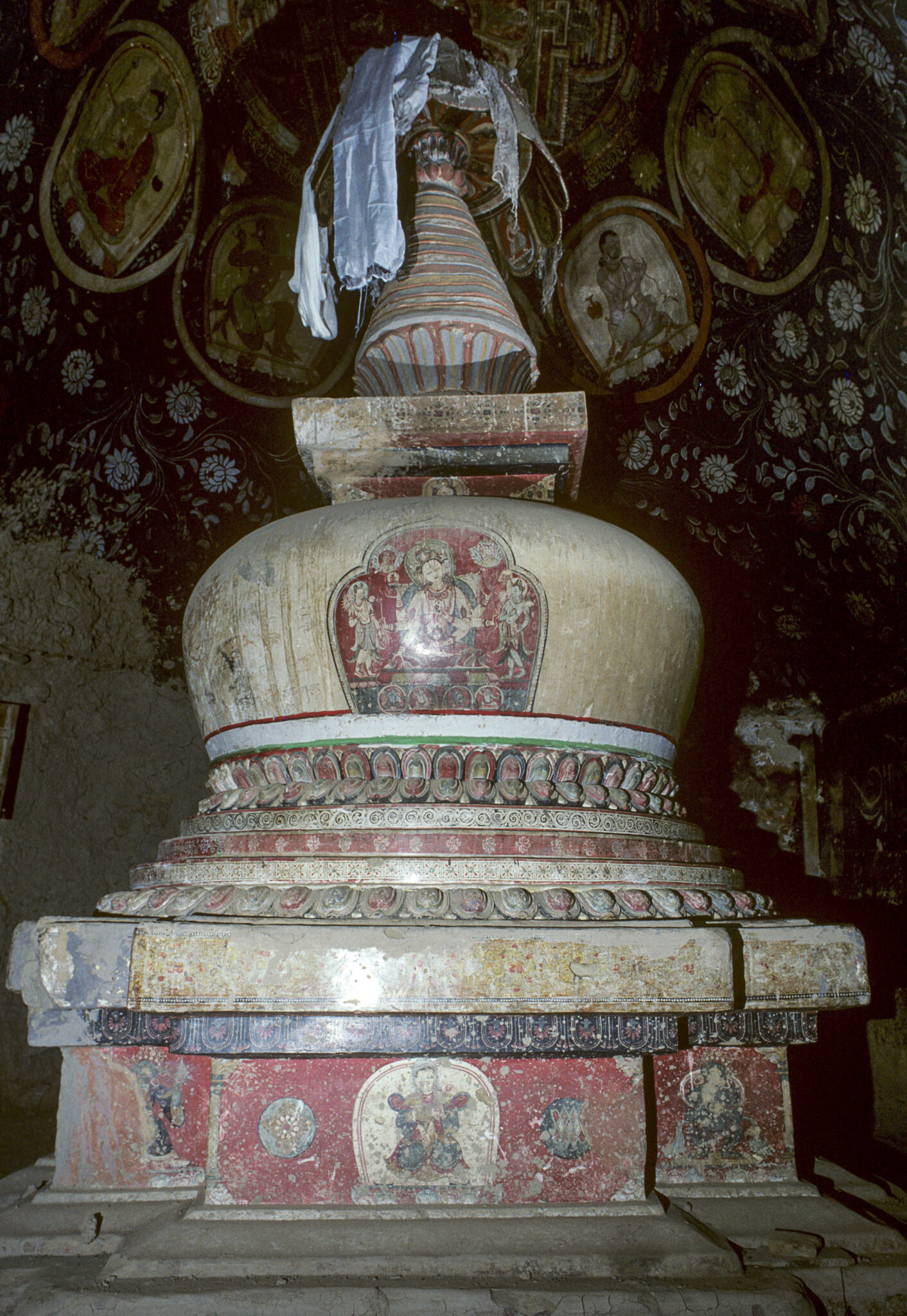
The Luri Chorten, as seen from the entrance, showing Ushnishavijaya and Dhritarashtra; Mustang, Nepal; ca. 1300; photograph by Philip Lieberman, 1993
The Luri Chorten, as seen from the entrance, showing Ushnishavijaya and Dhritarashtra; Mustang, Nepal; ca. 1300; photograph by Philip Lieberman, 1993
Why did someone scale a remote cliff, high in the Himalayas, to create a work of commemorative art? Art historian Christian Luczanits searches for answers about this mysterious cave. Its murals, likely painted by Nepalese artisans for Tibetan patrons, refer to Vajrayana Buddhist teachings and their transmission to Tibet. The cave may commemorate a Buddhist master, and the stupa inside the space possibly contains his remains. This stupa cave is one of many that once existed in the area.
Beri is a style of Tibetan painting based on Newar painting of the Kathmandu Valley of Nepal. With the destruction of many Indian monasteries in the thirteenth century, Nepal became an increasingly important source for Buddhist teachers and artisan.
Circumambulation means walking around something. Himalayan Buddhists often circumambulate as a form of veneration and generate/accrue merit by walking in a clockwise direction around stupas, monasteries, or sacred mountains. Bonpos do the same thing, except counter-clockwise.
In Buddhist context, donor is a person who contributes to or commissions a religious work of art. This act is intended to increase merit on behalf of the benefactor and is dedicated to the benefit of all. It is also usually done for a specific purpose, such as longevity, prosperity, or well-being; to advance religious practice; or to ensure a good rebirth of a deceased relative, teacher, or friend. A similar practice is also known in Hinduism and Bon.
In Buddhism, merit is accumulated positive karma, or positive actions, that lead to positive results, such as better rebirths. Buddhists gain merit by reciting mantras, donating to monasteries and those in need, performing pilgrimages, commissioning artworks, reproducing and reciting Buddhist texts, and other deeds with good intentions. It is believed that merit can also be transferred to others through rituals performed to gain merit for deceased family members help them achieve a better rebirth. Merit making is an important motivation for positive ritual action, and is a prerequisite for success of religious and even secular activity.
Stupas are monuments that initially contained cremated remains of Buddha Shakyamuni or important monks, his disciples, and subsequently other material and symbolic relics associated with the Buddha’s body, teaching, and enlightened mind. As representations of the Buddha’s presence in the world, stupas with their contents—texts, relics, tsatsas—continue to be important objects of Buddhist worship in their diverse forms of domed structures, multistoried pagodas, and portable sculptures. The original form of stupas was an earthen dome-shaped mound containing the remains in reliquary vessels or urns deposited within the innermost core. The dome would often be successively enlarged and surrounded by a path for a walk around in a clockwise direction and veneration (circumambulation)
In Mahayana Buddhism, Ushnishavijaya was the name of a particular dharani incantation popular across the Buddhist world. In the Vajrayana tradition, Ushnishavijaya became personified as a deity, usually depicted as a serene white six-armed female. Ushnishavijaya rituals are often performed as wishes for long-life, and the deity is one of the three deities of long-life, along with Amitayus and White Tara.
is well known for its caves containing a single large chorten, the Tibetan-style . Most of them, spread across the country, are in ruins, but Luri’s chorten is well preserved. The small cave cut into the conglomerate rock (fig. 2) contains paintings of exceptional quality, the chorten itself outstanding for its highly polished surface. Accordingly, the cave has gained considerable scholarly attention, but problems of attribution remain. Further, attention on the cave’s art has distracted from any attempt to explain its remote location and appearance.
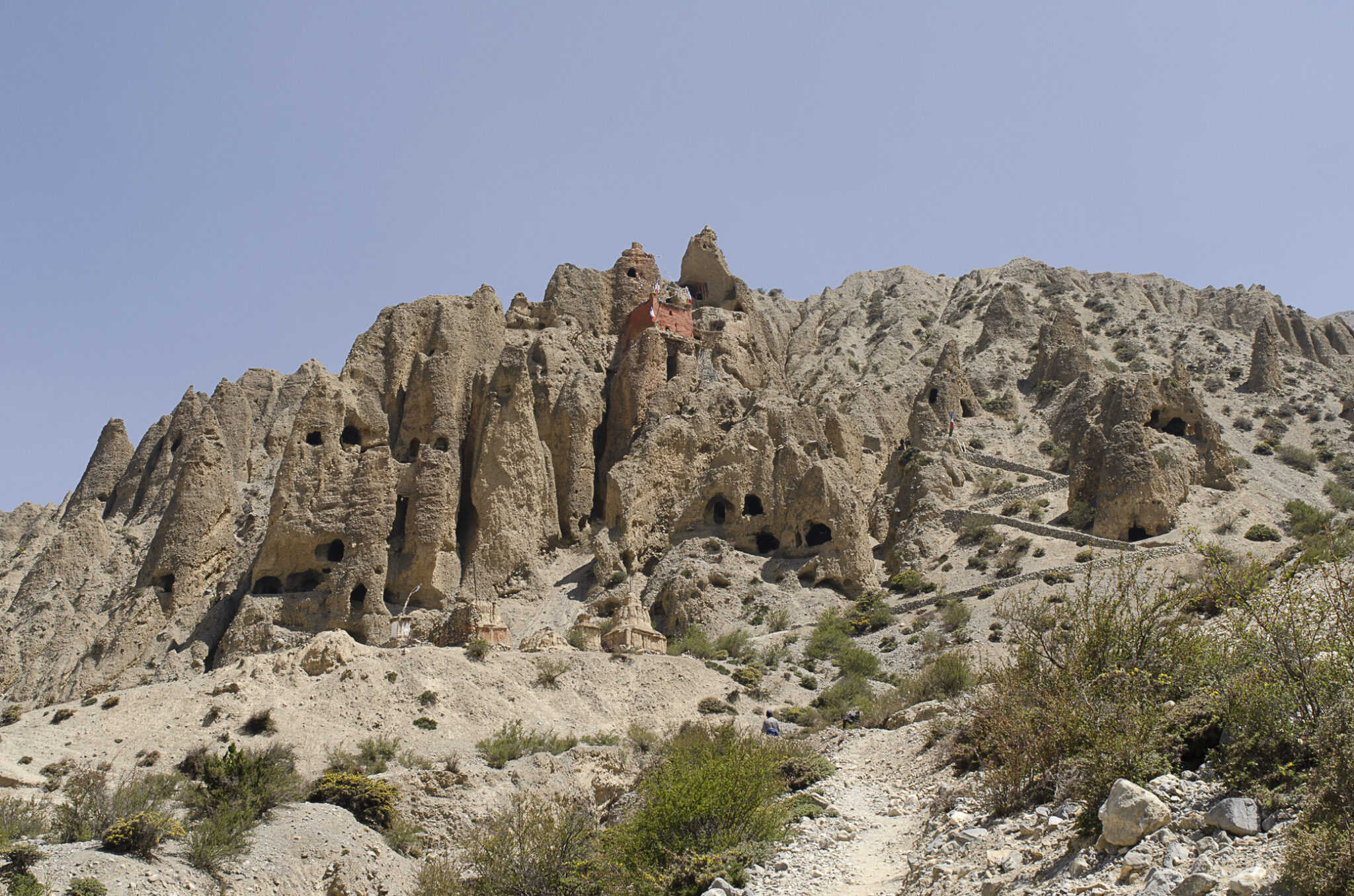
The cliff containing the Luri chorten cave when approached from the south; Mustang, Nepal; photograph by C. Luczanits, 2012, D4172
Despite its early date, the chorten already has a shape that takes precedence in Tibet from the fifteenth century on. A multicornered base forms the protective foundation of the structure. Its central surfaces are painted with the Four Great Kings flanked by two of the Eight Auspicious Symbols; Dhritarashtra, the protector of the East, flanked by the wheel and the endless knot, is seen here. The short faces on the corners feature two protective deities each, some of them challenging to identify precisely. A jewel-ornament pattern and a garland mark the projecting steps at the throne’s top, indicating the distinguished nature of what comes above.
The chorten’s distinctive base is formed by three stepped rings, each painted with a different pattern. They sit on a single row of lotus petals and identify the structure as Chorten of Complete Victory. The dome, sitting on a double lotus base, features the long-life goddess , who is represented together with her assembly. On the other three sides of the dome, in clockwise succession, are the Bodhisattvas and in four-armed forms and the protector . They form a group called the protectors of the three families, the term “family” here designating deities of similar symbolism.
The dome is crowned by the square stepped , which carries the thirteen wheels of a conic spine surmounted by an umbrella and a sun and moon finial. The lower faces of the harmika feature four of the five esoteric buddhas, facing the eastern direction. The fifth buddha, , is represented by the chorten itself, and also in the center of the right above the chorten. In this nine-deity mandala, Akshobhya presides over the female personifications of the Eight Auspicious Symbols. The and eight offerings personified as goddesses are represented on the parasol and its sides, signifying a continuation of the life theme also on the level of the buddha representations.
The Akshobhya mandala above the chorten also centers the decoration of the cave itself, where it is surrounded by eight great siddhas within a common lotus scroll (fig. 3). These are, read from the east clockwise, Indrabhuti, Dombiheruka, Nagarjuna, Ghantapa, Padmavajra, Luyipa, Kukkuripa, and Saraha. They constitute a subgroup of the eighty-plus siddhas who symbolize the transmission of the highest esoteric Buddhist teachings to Tibet. That Padmavajra (fig. 4) takes here the position above the head of Akshobhya is significant, for it excludes a tradition context for the cave, as Virupa would be represented instead.
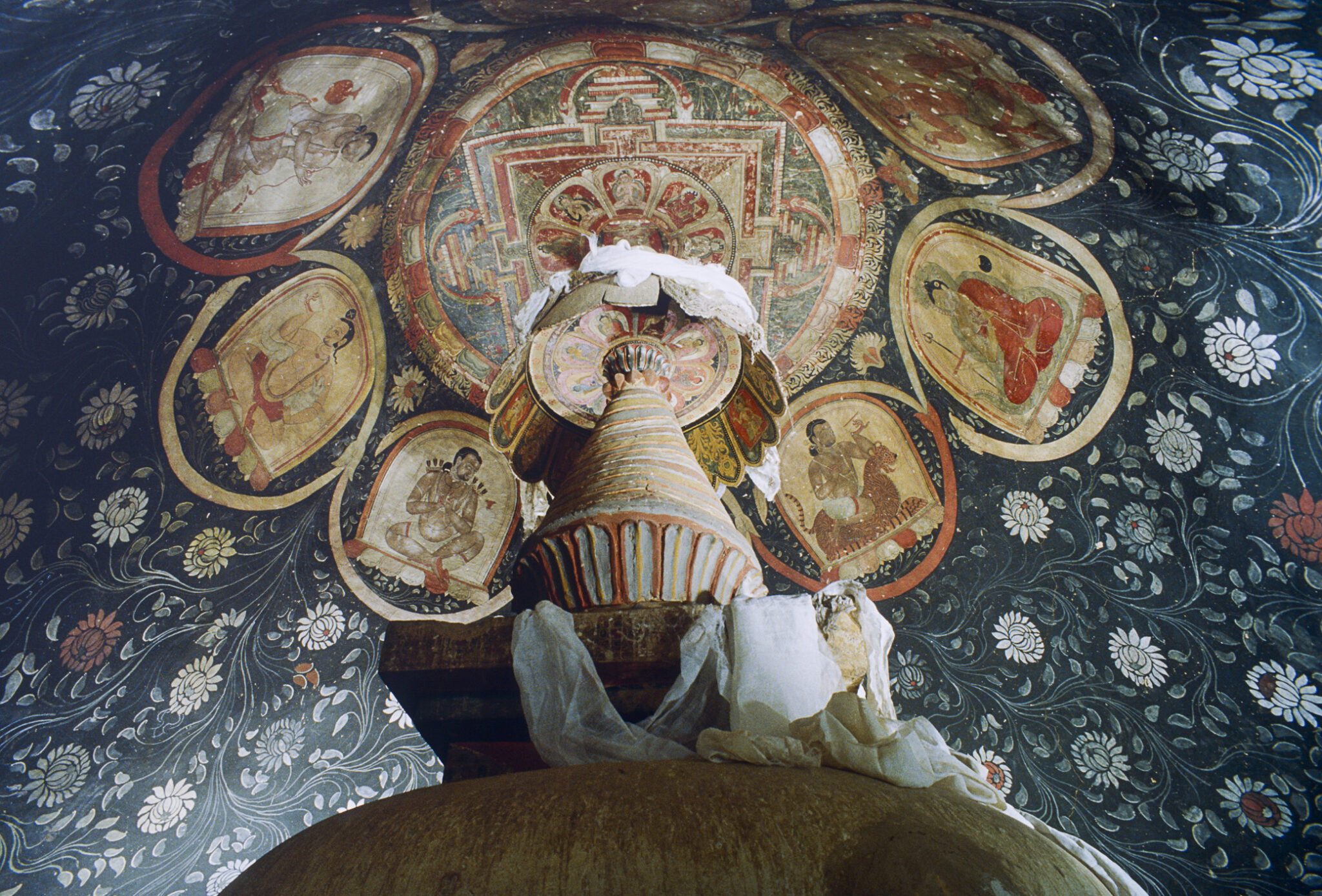
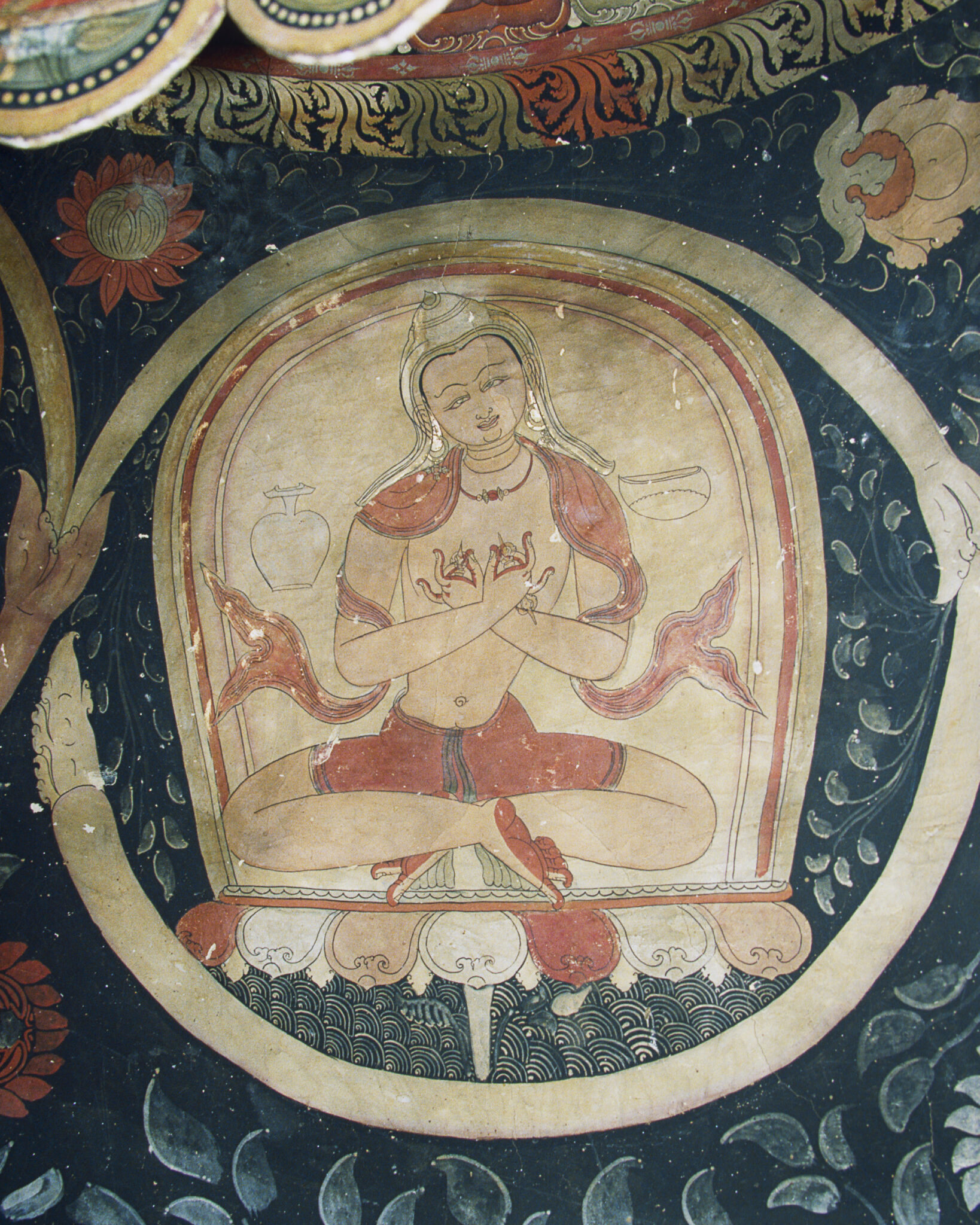
The lotus ring on which the mandala sits is also the central blossom of the scrollwork that expands toward the eight siddhas and then across the entire upper part of the cave against its black background, its predominantly white blossoms appearing like stars in the night sky (fig. 3).
The bottom part of the cave has straight walls, the back wall covered with further murals. If we assume that two panels are lost in the damaged left corner of the cave, then Shakyamuni flanked by his chief disciples forms the center of the composition. To his left is the portrait of a teacher wearing a rounded red hat (fig. 5), as is typical of but not exclusive to Sakya tradition portraits. On the right are , the primordial buddha of the highest esoteric teachings, , and . The composition is topped by a row of inscribed teachers forming a teaching transmission lineage, with a row of subsidiary deities and auspicious symbols below them (fig. 6). While the lineage cannot be identified precisely, the three lay and six monastic teachers indicate a derivation from one Marpa via a Ngok teacher, and thus a broader context.
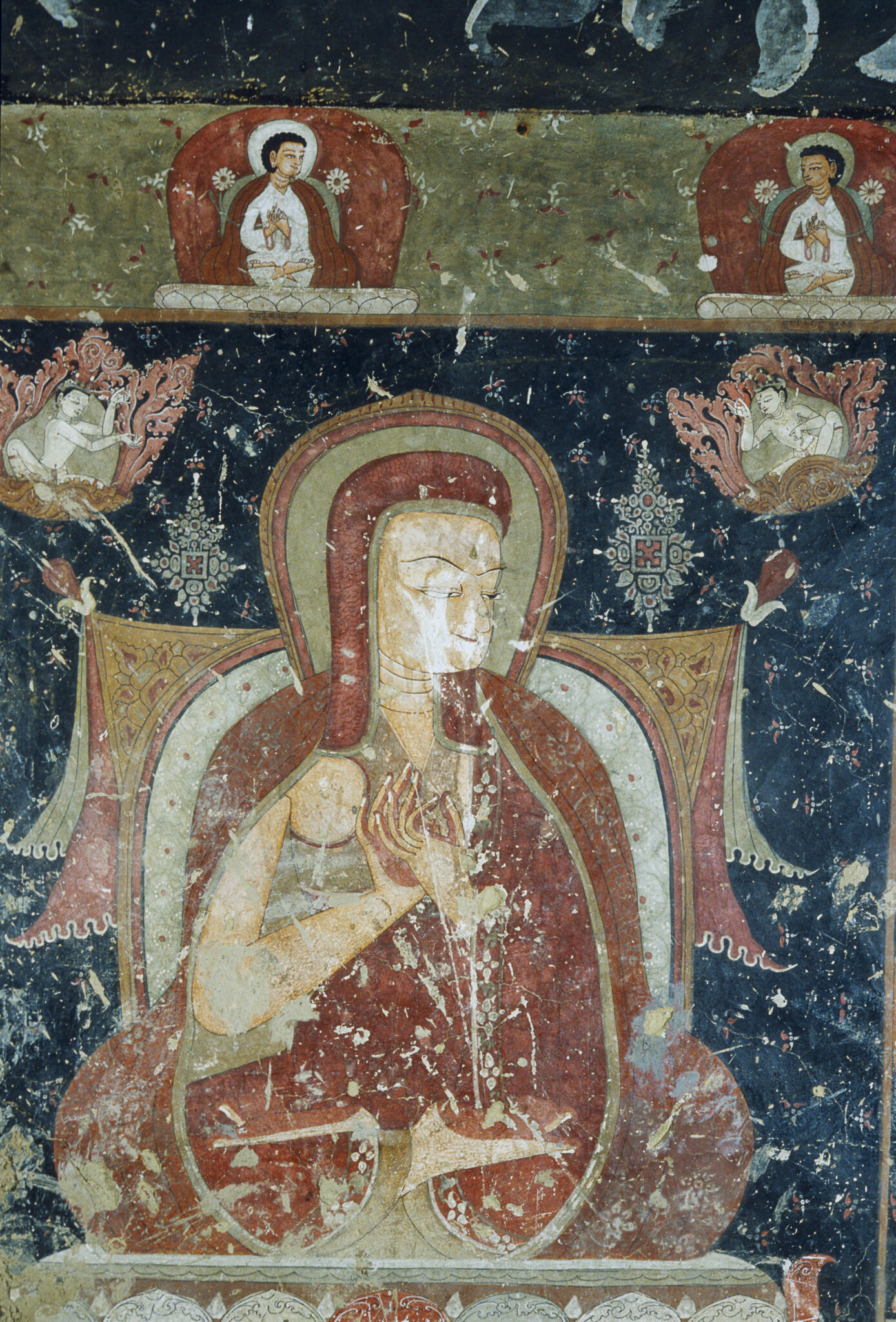
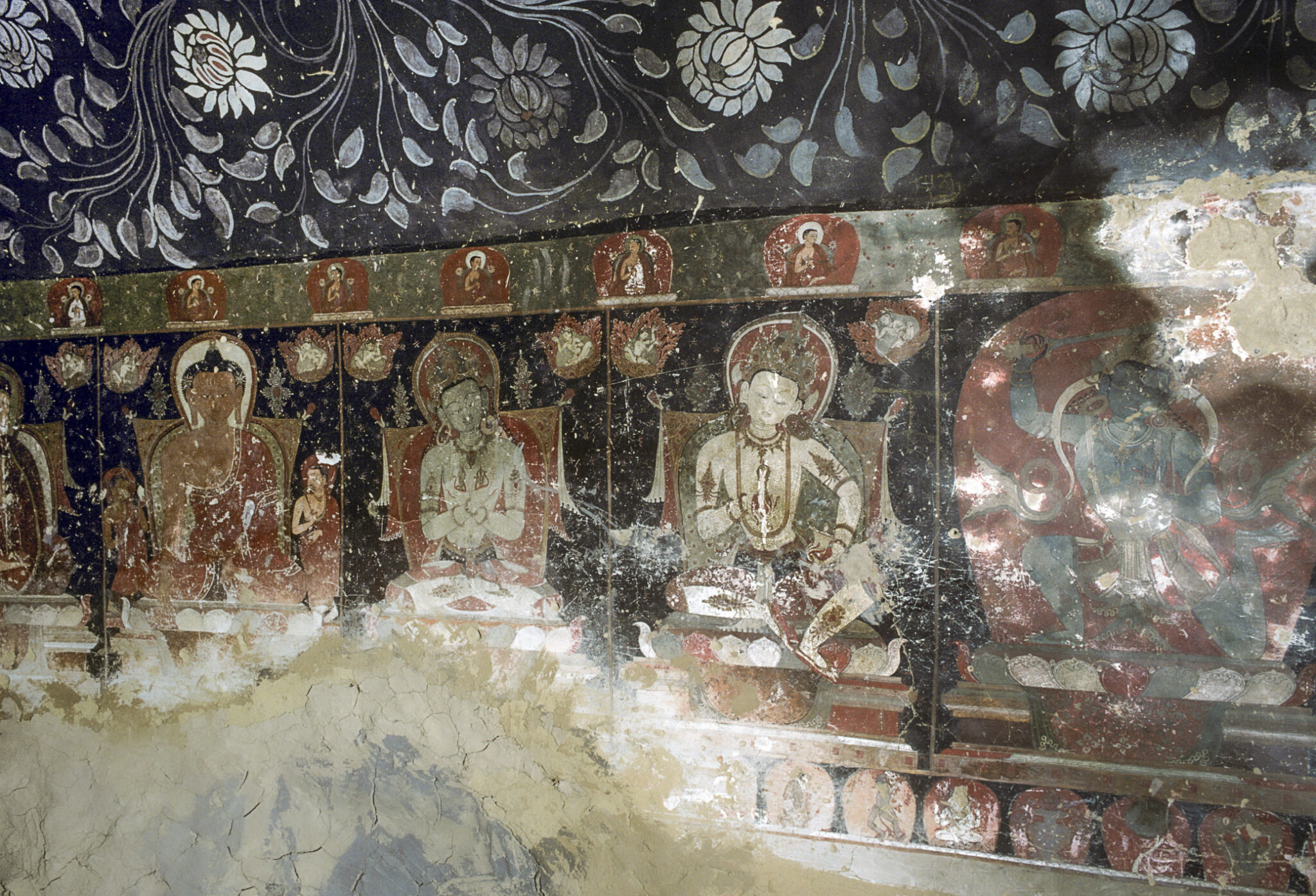
The right side wall is covered with a succession of on a common lotus base. The large six-syllable mantra referring to Avalokiteshvara occupies the left side of the panel. It is followed by the mantras of Shakyamuni, the Medicine Buddha , Vajrasattva, the five esoteric buddhas beginning with Akshobhya, Manjushri, Vajrapani, and Achala. Here, almost all deities depicted in the murals are referenced in their speech form.
Overall, the walls refer to the highest esoteric teachings and their earthly protagonists, the Indian siddhas surrounding the mandala on the ceiling (fig. 3) and the Tibetan teacher within his teaching transmission (fig. 5).
The Luri murals are remarkable for their sophistication. Expertly drawn, proportionate outlines frame the finely shaded figures. Textiles are decorated with fine patterns, signaling their delicate nature, but their ends fall in thick, fleshy folds. The jewelry is delicate and built of multiple layers of color. Where appropriate, fine scrollwork covers the surfaces, and flower blossoms envelop the backgrounds.
Most of the shapes and details seen in the Luri paintings find their direct comparison in Kathmandu Valley painting, and they are thus considered exemplary for Tibetan of the early style, traditionally called the Nepalese style or . Most notable among the motifs are the clouds in the shape of a three-pointed leaf flanking the heads of and the figures on the main wall. Technically, the highlighting of exposed areas through a white line is particularly noteworthy and results in a single or double white line on the nose ridge.
The Luri cave’s attribution has to rely on stylistic comparison. Close similarities with the most pronounced Beri-style paintings for Tibetan patrons preserved on and at Zhalu Monastery, in southeastern Tibet, and assumptions about the relative chronology and dates of the murals there resulted in an attribution of Luri to about 1300. However, this is merely a hypothesis, as none of the comparators can be securely dated, and there are not enough dated Kathmandu Valley paintings around that time that could be used for comparison.
It is clear, though, that the Luri cave marks the moment when Beri-style murals in Mustang began to flourish, leading toward the earlier of the two large temples in the regional capital Lo Montang, the Jampa Lhakhang ( Temple). A local variant of this style is also documented in recently studied manuscript preserved locally, some of them predating the Luri cave.
Surveying the art of Mustang preceding the rise of its kingdom in the fifteenth century, it is remarkable that depictions on manuscripts and the stupa caves feature single monastic teachers. These must have been charismatic teachers of great influence within the community. The Luri cave most likely is a commemorative monument constructed after the passing of such a charismatic teacher, the stupa plausibly containing his remains and the painting on the main wall of the cave representing him.
A nearby stupa cave called Tashi Gheling or Tashi Kabum reduces its decoration to the portrait of the teacher and Shadakshari Lokeshvara (fig. 8), the form of Avalokiteshvara named after and representing the six-syllable mantra om mani padme hum, which is also written on the wall. The comparison of the caves shows that besides the teacher portrait, Avalokiteshvara plays a special role, presumably because of the salvific powers ascribed to him. His prominence may well be early evidence for the practice of a so-called mani dungchur, the recitation of the mantra of this one hundred million times on behalf of the deceased. This, or a similar practice, may also explain the panel on the entry wall of the Luri chorten cave covered with stroke marks (fig. 9) denoting the repeated completion of a certain religious task.
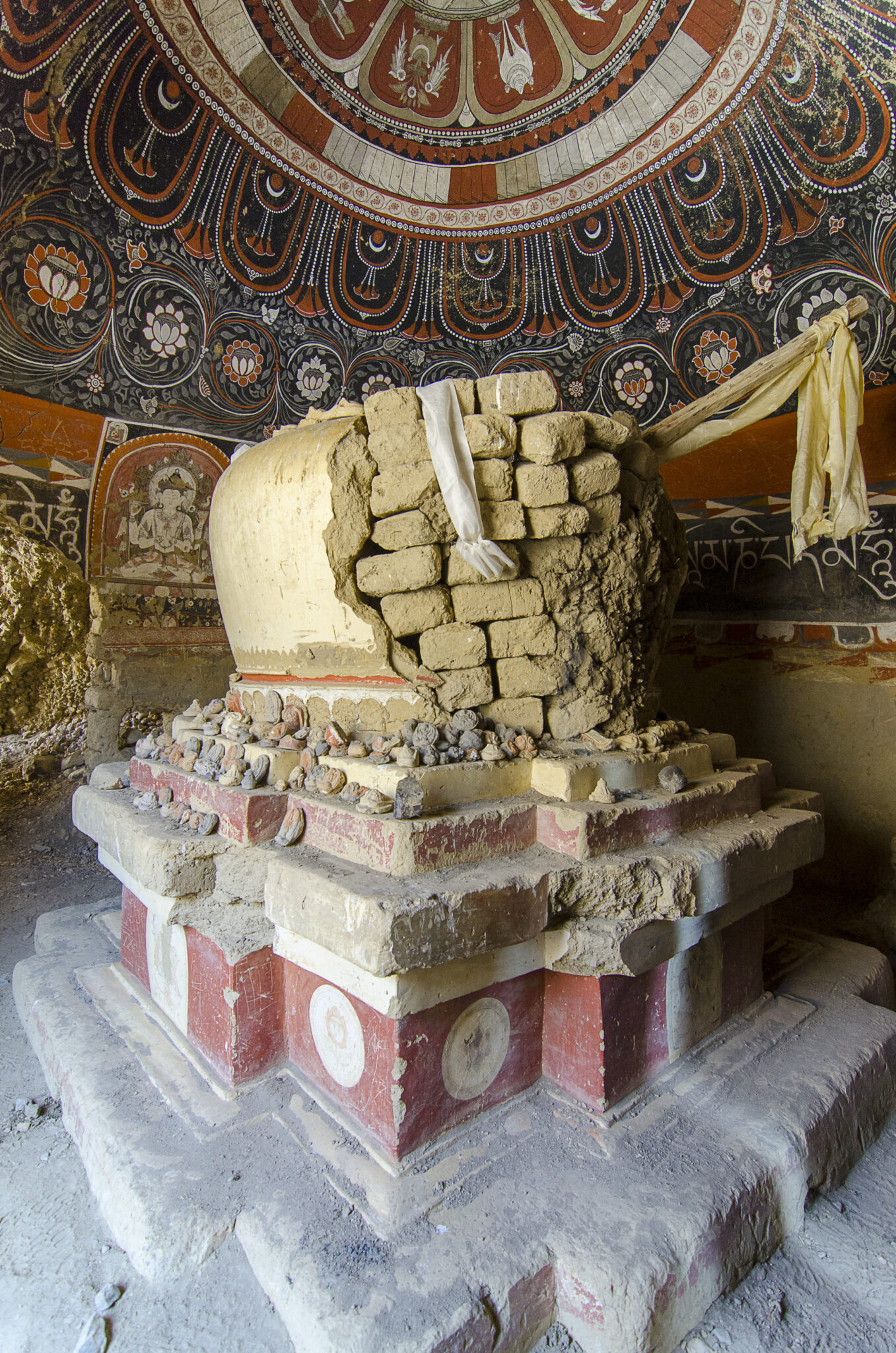
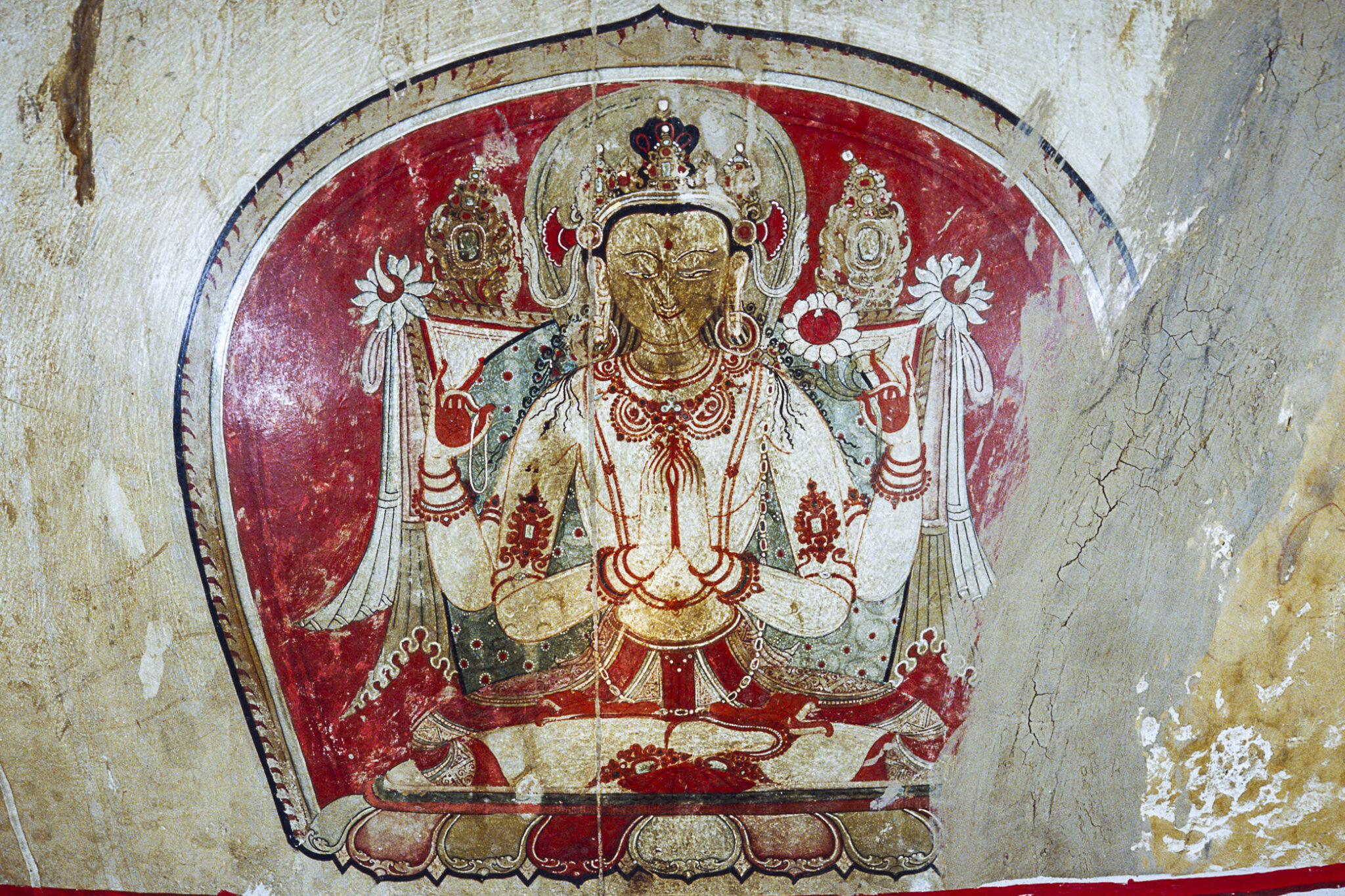
Shadakshara Lokeshvara, a four-armed form of Avalokiteshvara, on the western side of the chorten’s dome; Mustang, Nepal; ca. 1300; photograph by Jaroslav Poncar, 1996
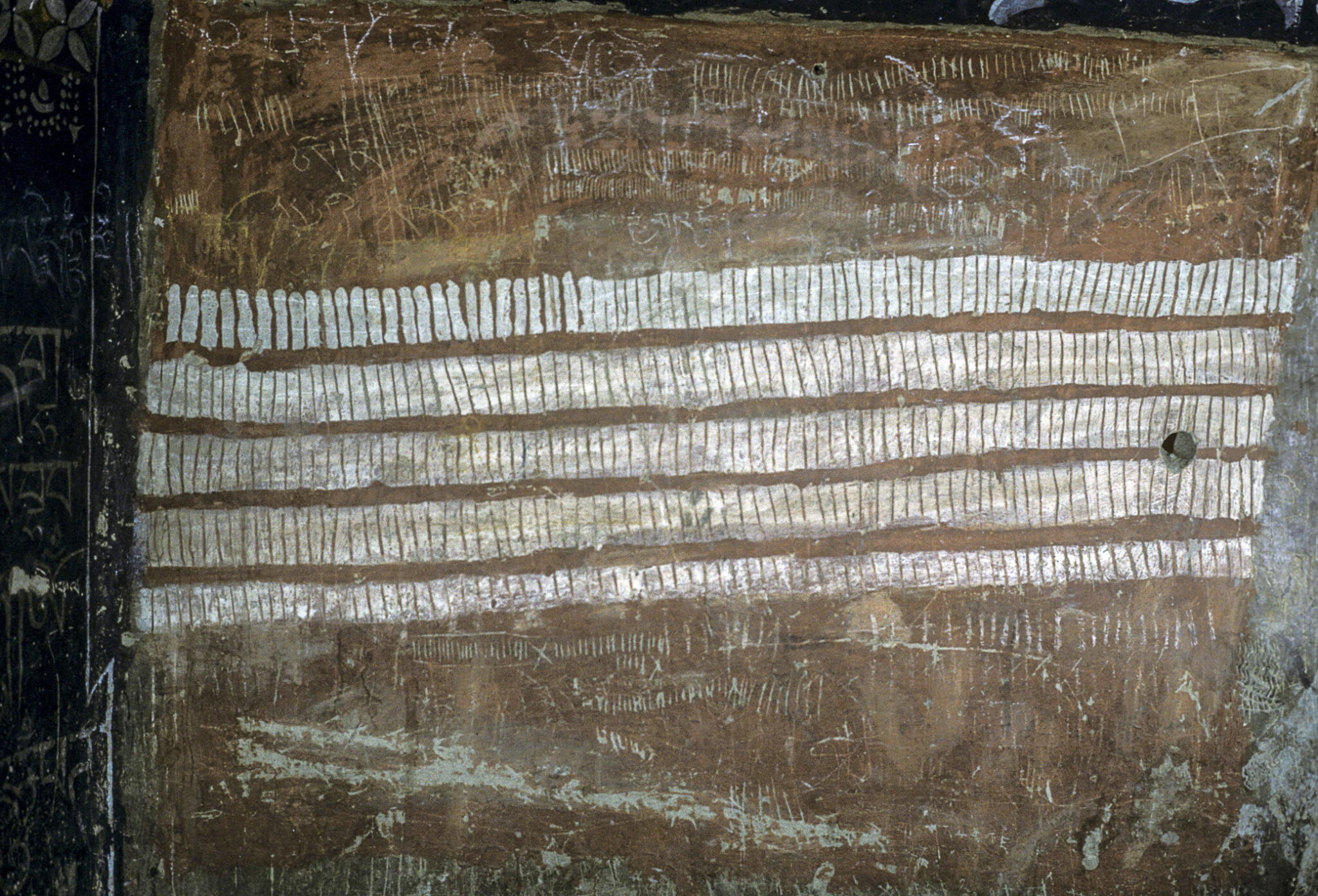
A local example of a chorten of the Luri type used to fulfill the intentions of a deceased teacher is preserved at Namgyal (fig. 11). This stupa, identified by inscription as Liberation through Seeing, is dedicated to Kunga Drolchok, 1507–1566, a prominent teacher of the tradition. It is likely that the Luri stupa is a precedent in this regard.
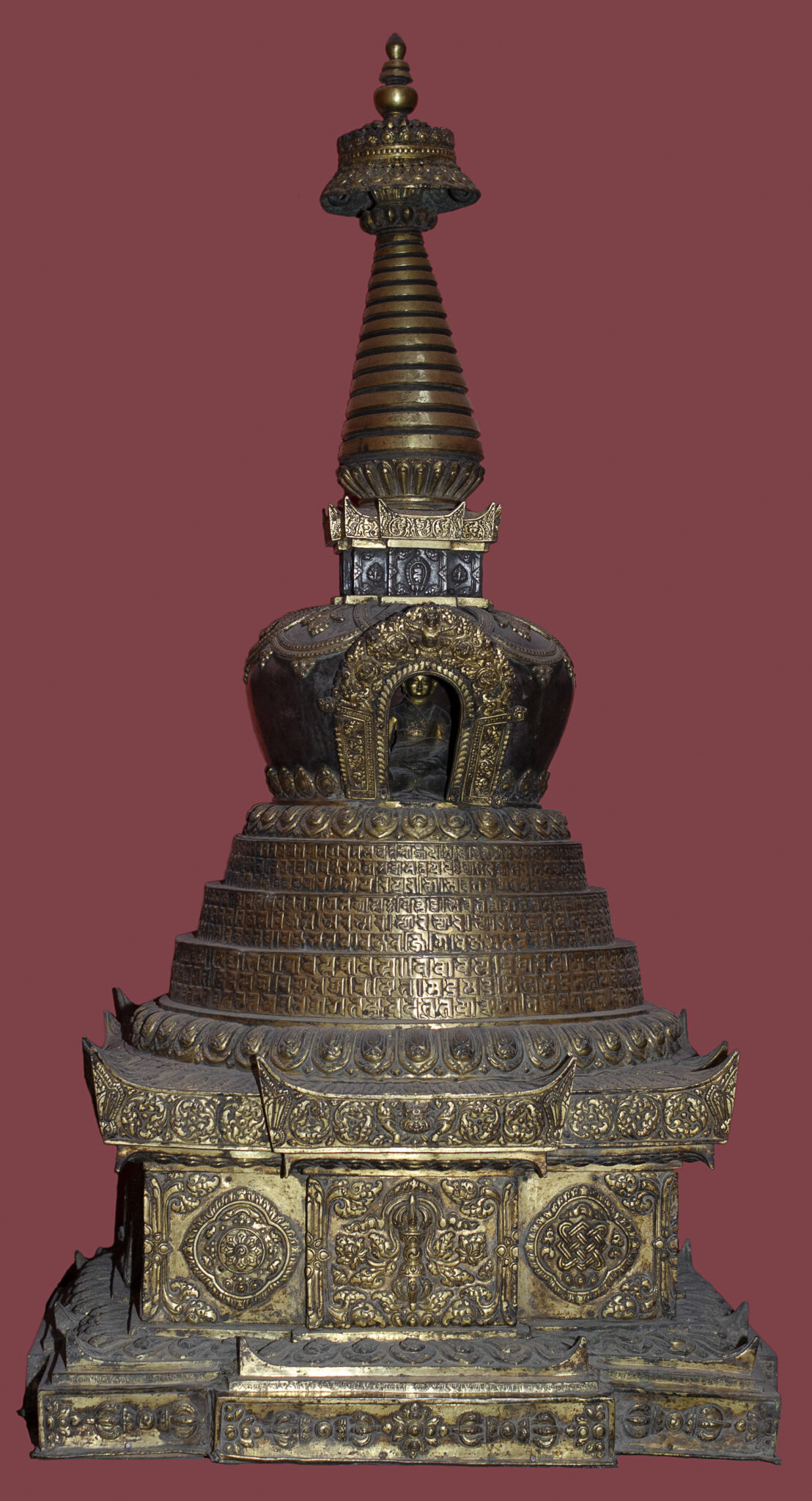
Chorten constructed in the memory of Kunga Drolchok (1507–1566); Namgyal Monastery; Mustang, Nepal; ca. 1568; 51 1/8 × 27 1/8 × 27 1/8 in. (130 × 69 × 69 cm); photograph by C. Luczanits, 2018, D2836
A commemorative purpose also fits the location and the black background of the Luri cave. High up on a cliff with originally no or very little light and almost no space for worship beyond , the Luri cave certainly was not meant for group visits. One wonders if the cave was meant to be casually visited at all, a question that also applies to other Buddhist cave monuments. As such, the sumptuous decoration of the cave is solely meant to create the most suitable backdrop for the initial entombment and accrual of , as well as the subsequent rituals. They qualify the teacher commemorated as an exceptional religious practitioner with an illustrious religious pedigree and backed by an affluent community. Local tradition holds that this teacher is a certain Kunzang Jalu, literally, “all-good rainbow body,” but nothing is known about this individual.
A documentation of the Luri cave with photographs by Philip Lieberman and Jaroslav Poncar is found online: https://luczanits.net/sites/Luri.html. Without these photographs, generously provided, and a research grant from the Arts and Humanities Research Council (AHRC) for “Tibetan Buddhist Monastery Collections Today” (Grant Ref: AH/N00681X/1), which facilitated the last visit to the site, this study would not have been possible.
Studies directly focused on the cave are Niels Gutschow, “The Chörten of the Cave at Luri,” in Ancient Nepal, vol. 136, 1994, 137–45; Helmut F. Neumann, “The Wall Paintings of the Lori Gonpa,” Orientations 25, no. 11 (November) (1994): 79–91 and 1997; Helmut F. Neumann and Heidi A. Neumann, “Early Wall Paintings in Lo: Luri Reconsidered,” in Wonders of Lo: The Artistic Heritage of Mustang, ed. Erberto Lo Bue (Mumbai: Marg Foundation, 2010), 64–75.
For different interpretations of this stupa type, see Yael Bentor, “In Praise of Stūpas: The Tibet Eulogy at Chu-Yung-Kuan Reconsidered,” Indo-Iranian Journal 38 (1995): 31–54; Tadeusz Skorupski, “Two Eulogies of the Eight Great Caityas,” in Buddhist Forum, ed. Tadeusz Skorupski (Tring: The Institute of Buddhist Studies, 2001), 37–56.
On early representations of the eight great siddhas, see Christian Luczanits, “The Eight Great Siddhas in Early Tibetan Painting from c. 1200 to c. 1350,” in Holy Madness: Portraits of Tantric Siddhas. Linrothe, ed. Rob Linrothe (Rob: Rubin Museum of Art, 2006), 76–91.
The captions identifying the teachers are mentioned in Ian Alsop, “The Wall Paintings of Mustang,” in Nepal: Old Images, New Insights, ed. Pratapaditya Pal (Mumbai:Marg Publications, 2004), 128–39, 138n2, and briefly discussed in Roberto Vitali, The DGe Lugs Pa in Gu Ge and the Western Himalaya (Dharamshala: Amnye Machen Tibetan Institute for Advanced Studies, 2012), 96–100. While the reading of the captions in the latter is partially erroneous, and more can be said about the depicted teachers, they do not provide conclusive information.
See David P. Jackson, The Nepalese Legacy in Tibetan Painting: Early Beri to Ngor, Exhibition catalog, Masterworks of Tibetan Painting Series 2 (New York: Rubin Museum of Art, 2010), 103, https://issuu.com/rmanyc/docs/nepalese_legacy_96, whose interpretation of the Tibetan teachers represented is erroneous.
In Helmut F. Neumann and Heidi A. Neumann, “Early Wall Paintings in Lo: Luri Reconsidered,” in Wonders of Lo: The Artistic Heritage of Mustang, ed. Erberto Lo Bue (Mumbai: Marg Foundation, 2010), 73–74, a late thirteenth-century date is proposed for the Luri cave, slightly earlier than in their previous publications.
See Christian Luczanits, “Illumination Programs: The Visual Subtext of Two Text Collections,” in Two Illuminated Text Collections of Namgyal Monastery. A Study of Early Buddhist Art and Literature in Mustang, ed. Christian Luczanits and Markus Viehbeck (Kathmandu: Vajra, 2021), 132–43.
See Robert H. Sharf, “Art in the Dark: The Ritual Context of Buddhist Caves in Western China,” in Art of Merit: Studies in Buddhist Art and Its Conservation, Proceedings of the Buddhist Art Forum 2012, ed. David Park, Kuenga Wangmo, and Sharon Cather (London: Archetype, 2013), 38–65.
See Roberto Vitali, The DGe Lugs Pa in Gu Ge and the Western Himalaya (Dharamshala: Amnye Machen Tibetan Institute for Advanced Studies, 2012), 96–97.
Neumann, Helmut F., and Heidi A. Neumann. 2010. “Early Wall Paintings in Lo: Luri Reconsidered.” In Wonders of Lo: The Artistic Heritage of Mustang, edited by Erberto Lo Bue, 64–75. Mumbai: Marg Foundation.
Sharf, Robert H. 2013. “Art in the Dark: The Ritual Context of Buddhist Caves in Western China.” In Art of Merit: Studies in Buddhist Art and Its Conservation; Proceedings of the Buddhist Art Forum 2012, edited by David Park, Kuenga Wangmo, and Sharon Cather, 38–65. London: Archetype.
Christian Luczanits, “The Chorten Cave of Luri: Commemorative Monument for a Charismatic Teacher,” Project Himalayan Art, Rubin Museum of Art, 2023, http://rubinmuseum.org/projecthimalayanart/essays/the-chorten-cave-of-luri.
Lorem ipsum dolor sit amet consectetur adipisicing elit. Cum nihil placeat pariatur deserunt eius ullam incidunt maxime sunt ipsam. Ipsa, provident, laudantium, rem assumenda laboriosam veniam autem voluptas sint officia distinctio enim aut explicabo fuga animi voluptatum earum recusandae excepturi atque dignissimos iste? Exercitationem, praesentium eum. Harum ut maiores expedita exercitationem perspiciatis soluta aperiam dolores natus unde, sequi vitae debitis ex aliquam quas eum reprehenderit esse. Cumque amet et earum necessitatibus, repellendus ullam ducimus corporis architecto culpa placeat eum odit cum iure illo vitae rerum! Ullam et suscipit culpa? Eos voluptatum laudantium iste vero impedit adipisci maxime magni natus voluptatibus.
Get the latest news and stories from the Rubin, plus occasional information on how to support our work.